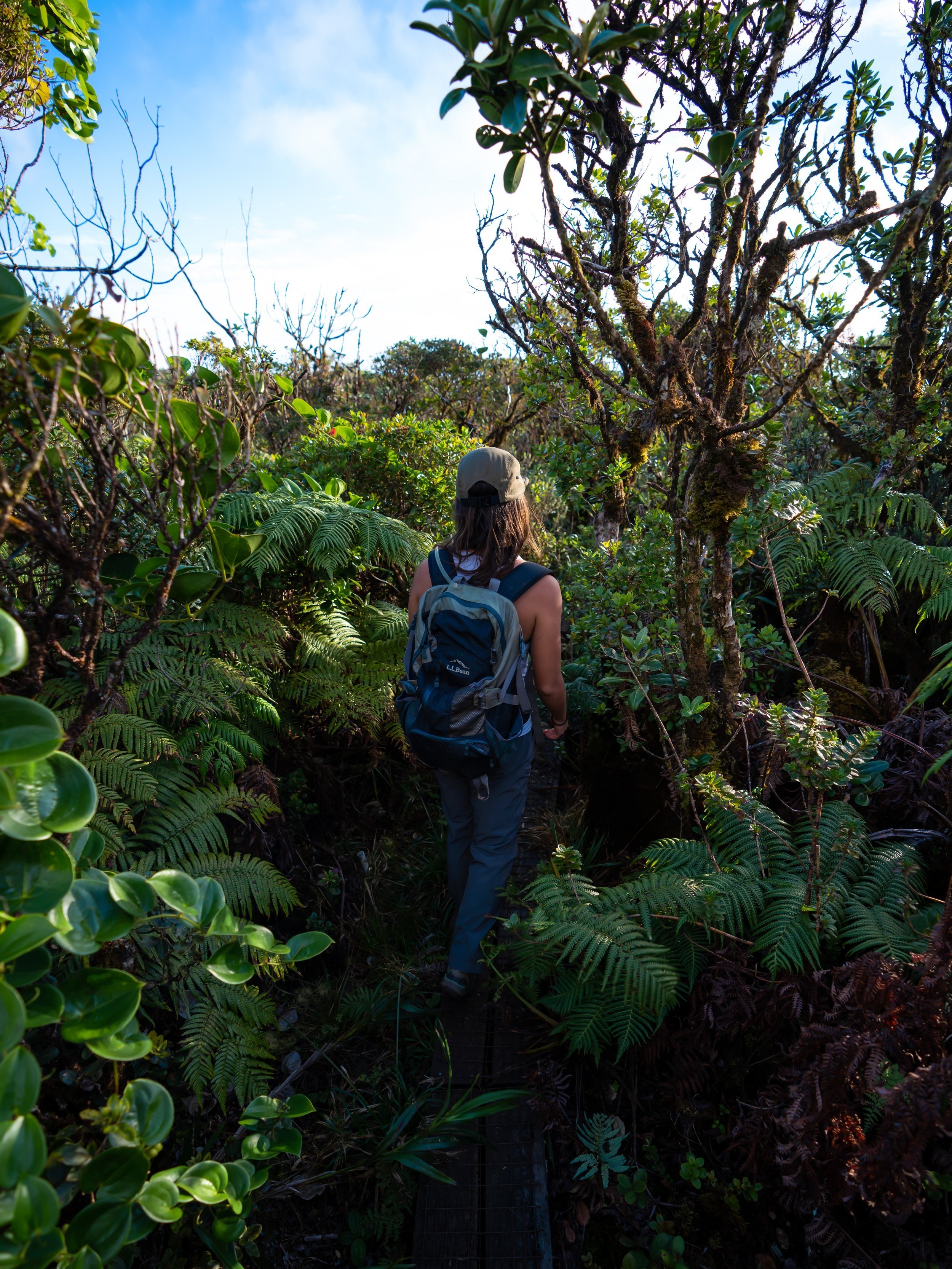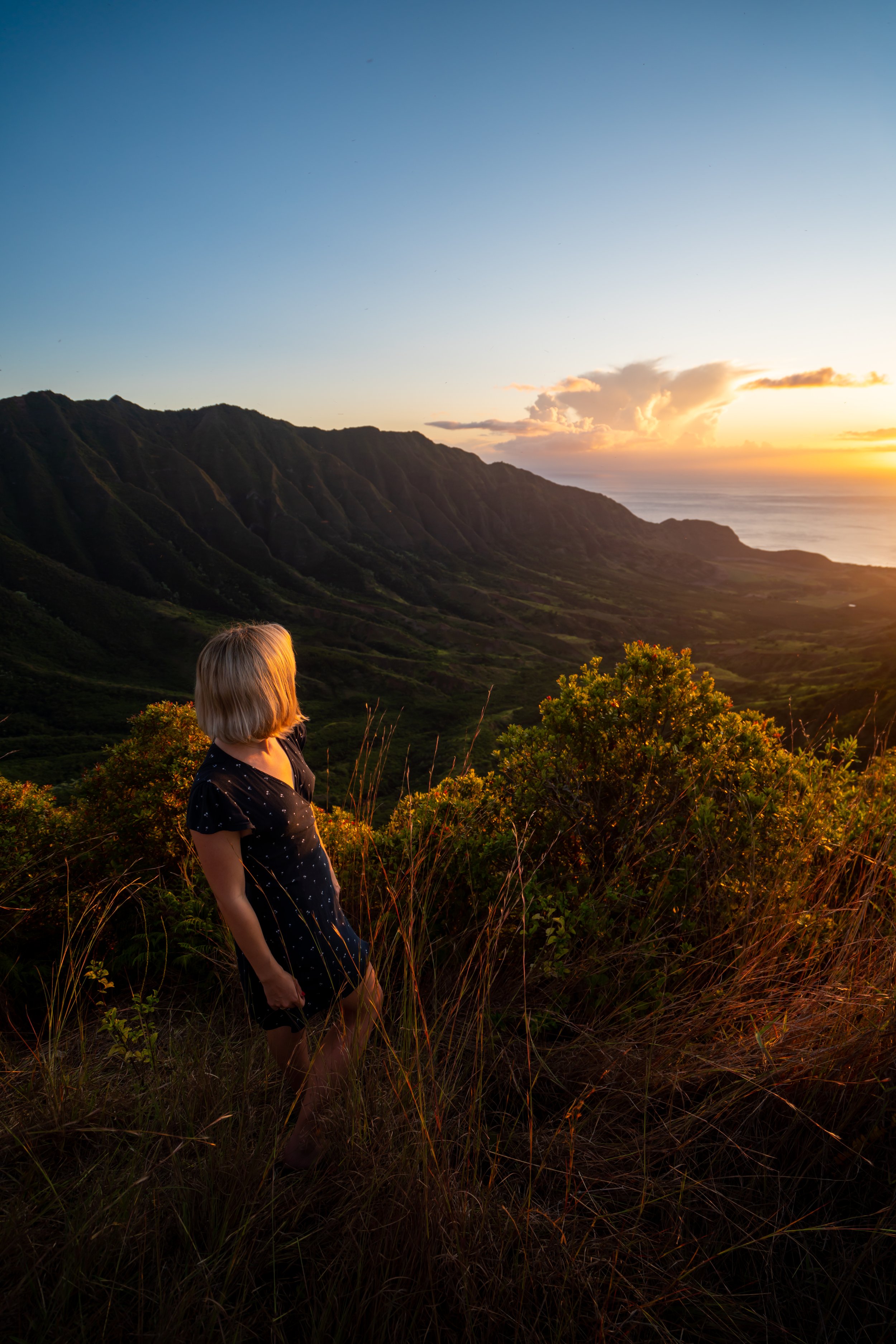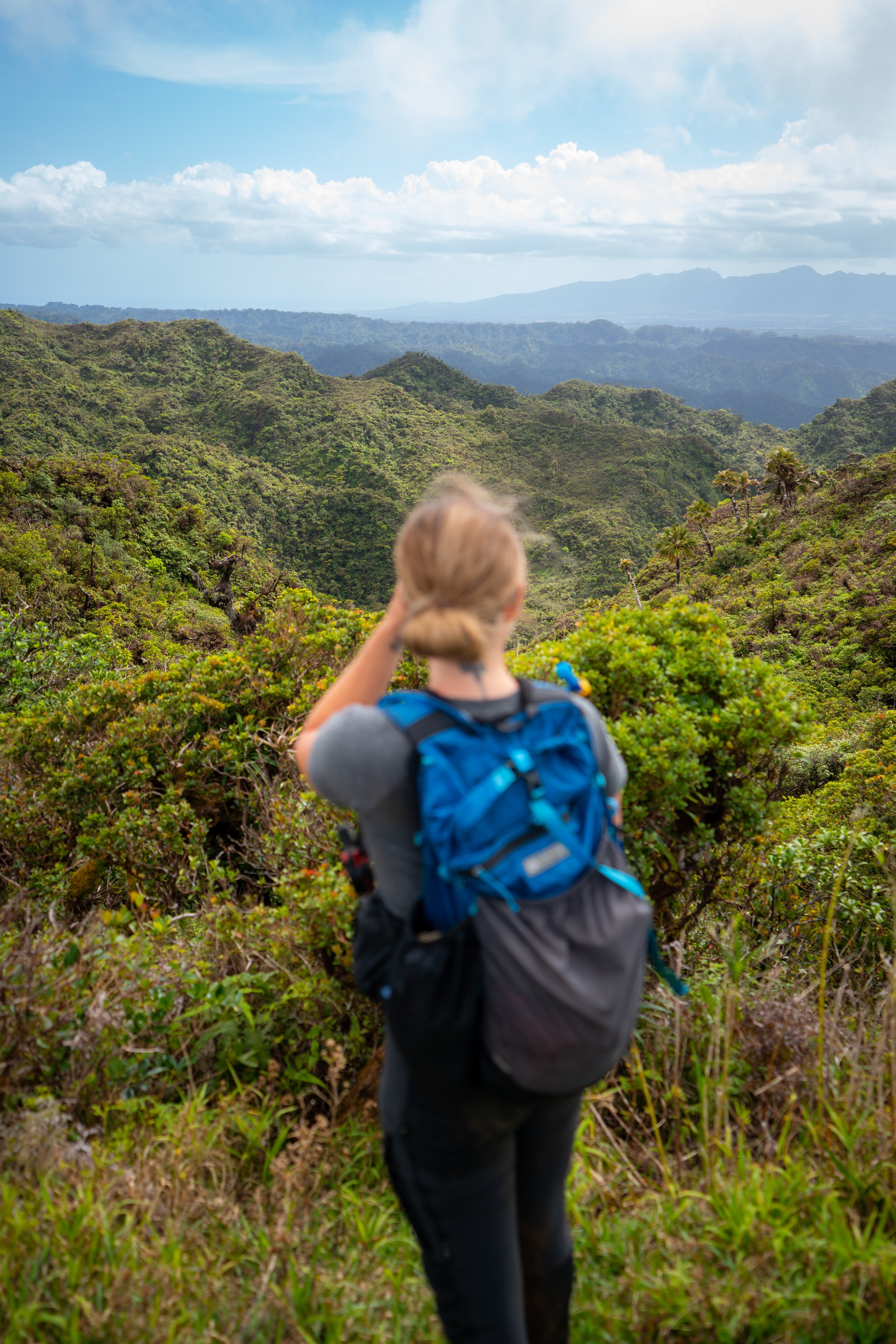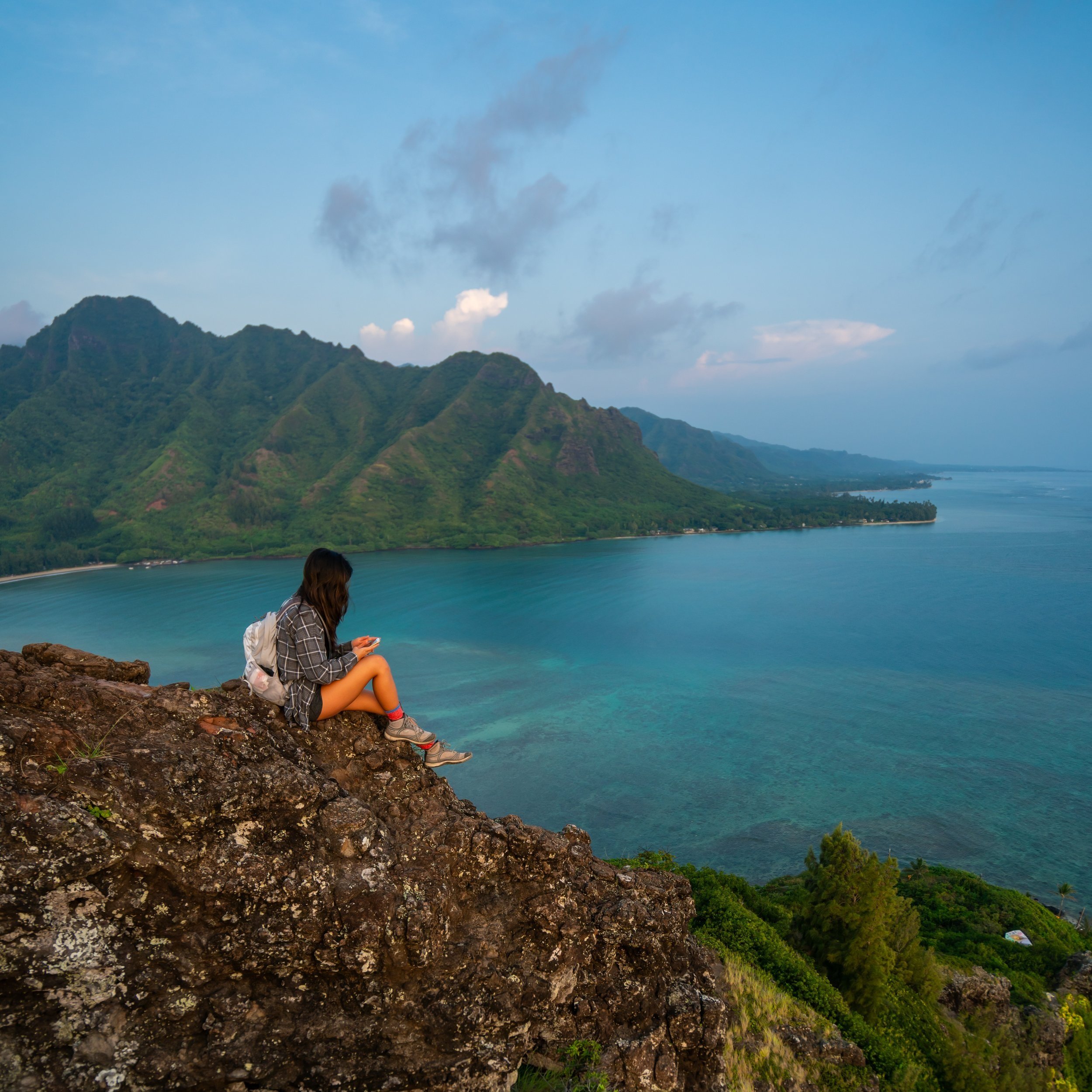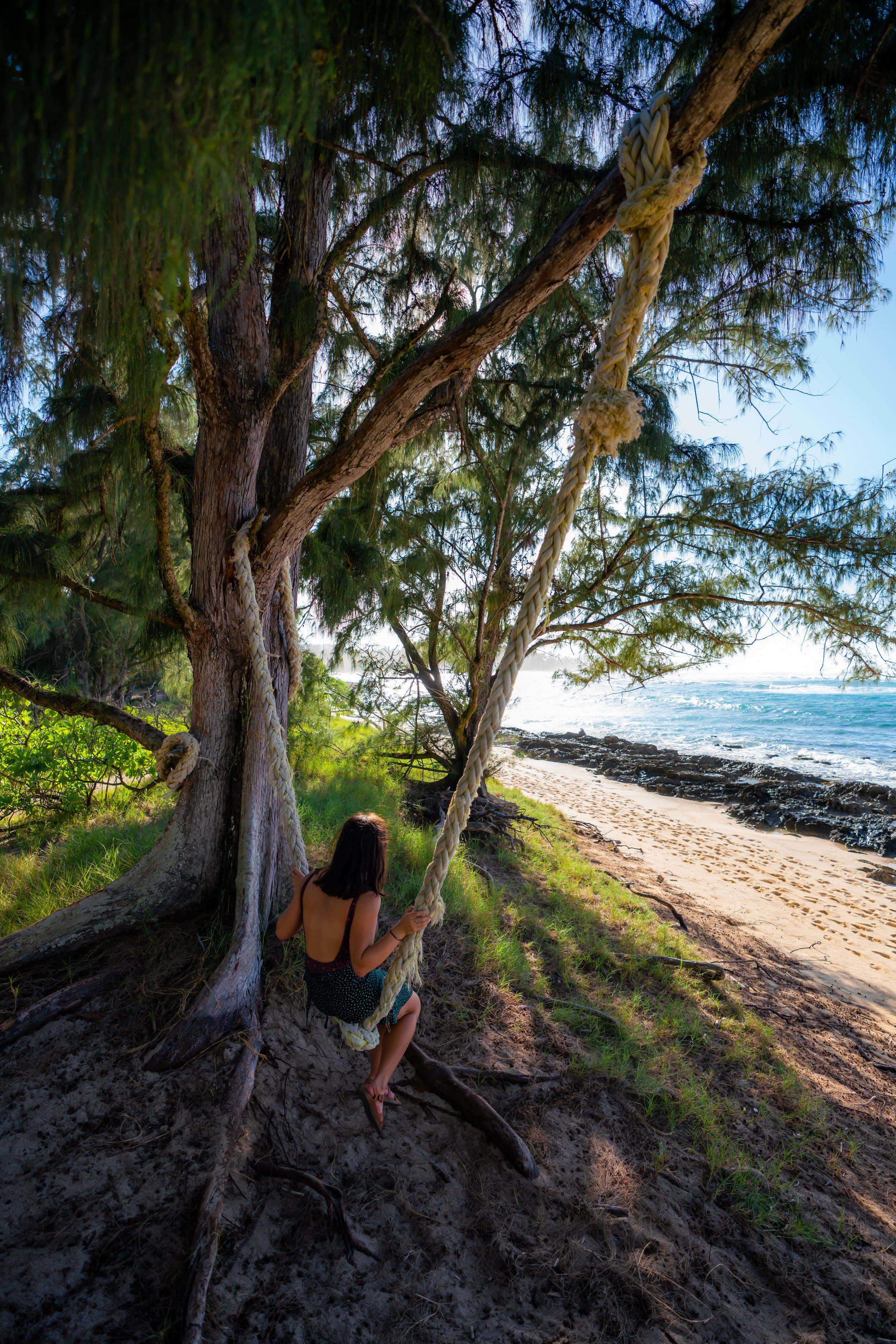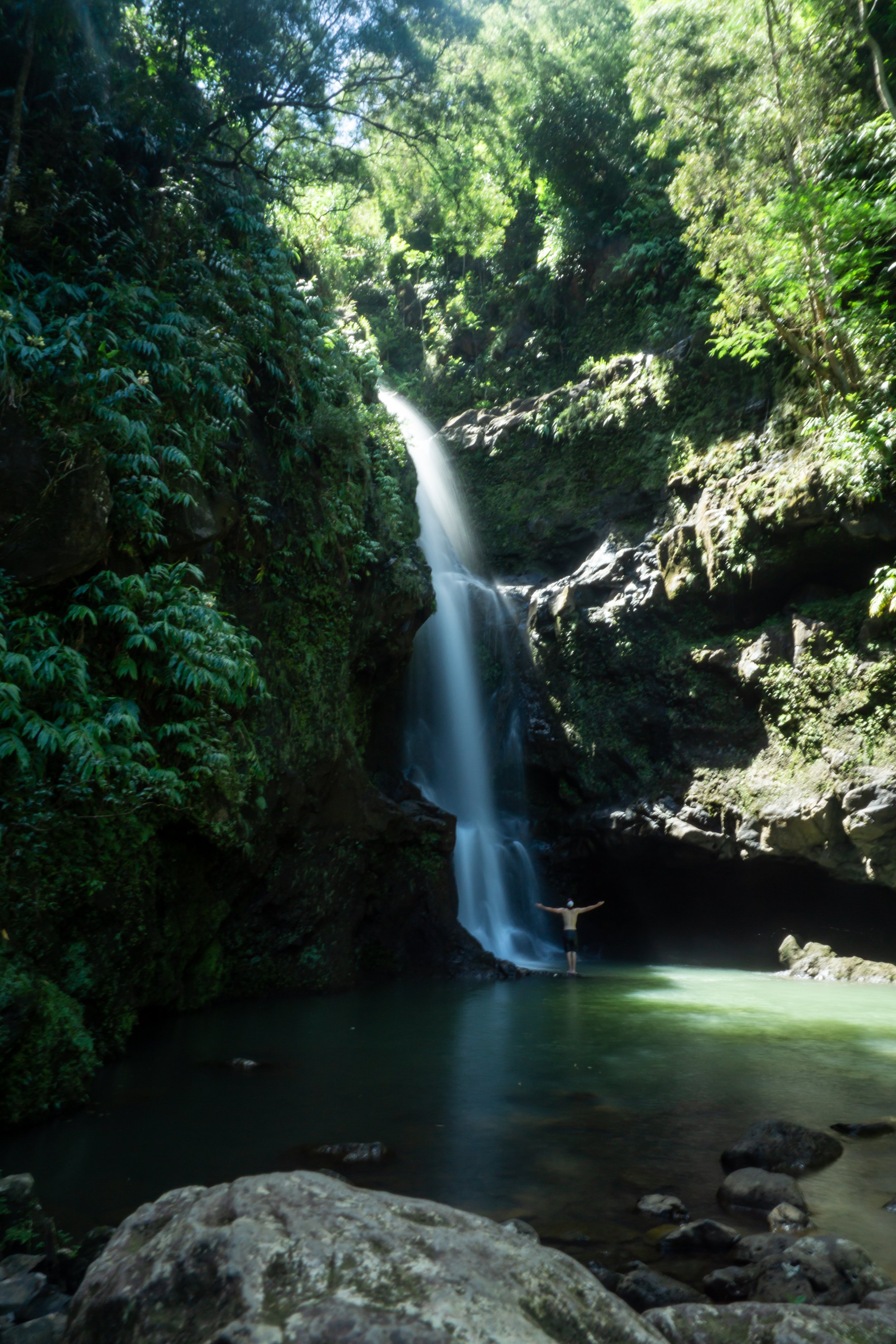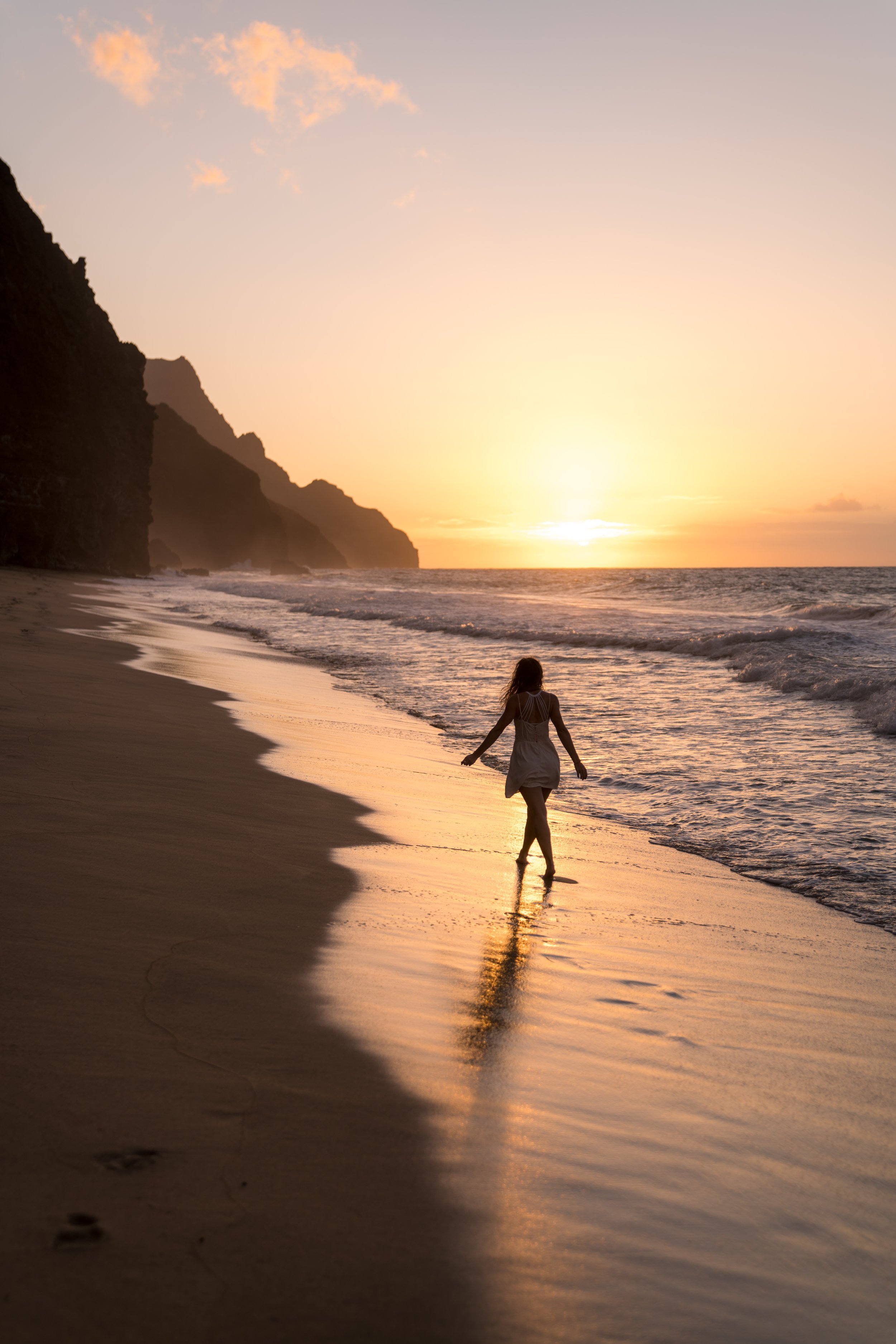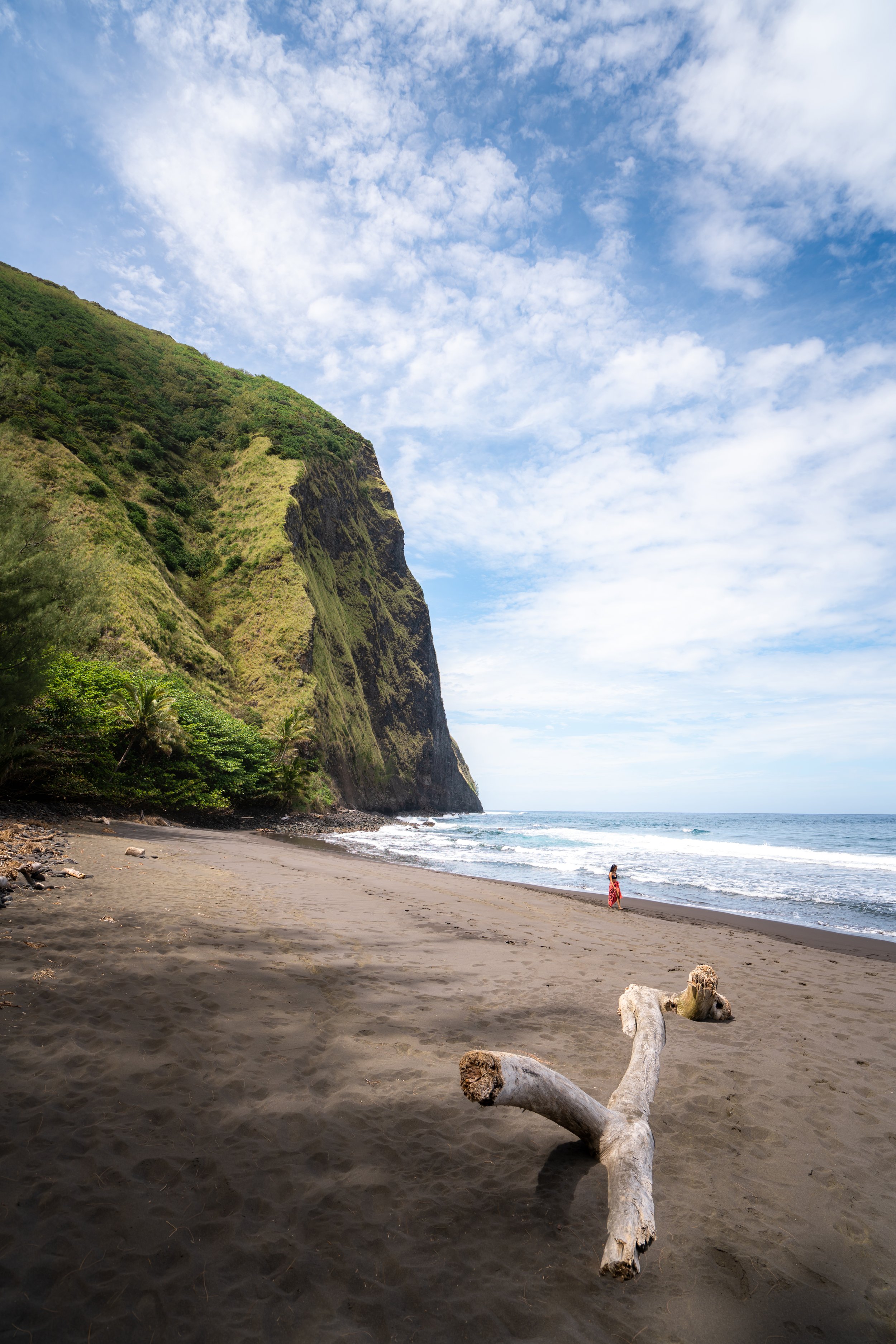Hiking the Kolekole Trail to Puʻu Hapapa on Oʻahu, Hawaiʻi
Distance: 3.1 miles / 5.0 km
The Kolekole Trail to Puʻu Hapapa in the Waiʻanae Mountains on Oʻahu is a fun, steep, and—most of all—beautiful day hike up one of the island’s most dramatic and exposed ridges!
It’s for these reasons that the Kolekole Trail to Puʻu Hapapa is one of my favorite hikes on Oʻahu—but be aware that the sheer exposure, combined with climbing Hawaiʻi’s loose volcanic basalt, is certainly not an adventure for all people, of all abilities.
For comparison, the scramble up the Waiʻanae Summit Trail (WST) side of the Puʻu Hapapa Loop is closest to a moderately challenging Class 3 climb—comparable to the Keaʻau Middle Ridge Trail on Oʻahu’s West Side. This is why many opt for the easier east side of the loop, instead of the WST.
All this to say, I have a personal bias for the Kolekole Trail because I enjoy the climbing, the exposure, and the crazy beautiful views—all located within such a short distance of the trailhead—not to mention that the Kolekole Trail is one of the more unique places to hike on Oʻahu, due to the access barriers that prevent most people from even attempting the hike.
How to Access the Kolekole Trail?
Since the Kolekole Trail is located on Schofield Barracks, an active military installation, all those entering are required to either be a valid DOD card holder, accompanied by someone who is a valid DOD card holder, or have a visitor pass.
That being said, the visitor pass is, by far, the most tedious and annoying method to access the hike, and being the case, many non-DOD card holders simply avoid the trail altogether because of this barrier.
U.S. Army Garrison Hawaiʻi: Visitor Information
When is the Kolekole Trail Open?
The Kolekole Trail is open on select weekends only.
To learn more about the trail’s furture schedule, hikers are encouraged to reference the U.S. Army website linked below.
U.S. Army Garrison Hawaiʻi: Kolekole Trail Status
Kolokole Trailhead Parking
Once you’re on Schofield Barracks, the Kolekole Trail is located at the summit of Kolekole Pass on the very back of the base.
Parking for the trail is on the side of the road, or in the little parking lot surrounding the trailhead.
After a number of consecutive closed weekends, the parking area/ trail can be exceptionally busy in the morning. That said, I love hiking Kolekole in the afternoon because of the beautiful evening light.
Google Maps Directions: Kolekole Trailhead
My Hawaiʻi Hiking Checklist
Osprey 3L Water Bladder - The Osprey 3L water bladder is the most universal hiking and backpacking water bladder on the market, and it’s my go-to because of the slide-off seal that allows it to be quickly filled from the top. Additionally, individual parts are easily replaceable, such as the bite valve.
Blister / Heel Protectors - I swear by these cheap, amazing heel protectors to prevent blisters for nearly every kind of hiking and backpacking that I do!
Black Diamond Headlamp - Personally, I recommend the Black Diamond Storm because it is one of the brightest, lightest, and longest-lasting headlamps on the market—and trust me, the weight-to-battery-life ratio really does matter!
Hiking / Trail Running Shoes - Depending on the type of trail, I prefer to use either the Keen Targhee for longer, more rugged hiking or the HOKA Zinal Trail-Running Shoe for lighter, less intense trails. In either case, both have been amazing to me for many years across countless environments, and both can be found in men’s and women’s sizes. - (Men’s Keen / Women’s Keen) (Men’s HOKA / Women’s HOKA)
Waterproof Rain Shell - You never know when it may rain, and I’ve learned over the years that a rain shell is far better than a rain jacket. By this, I mean that it’s best to have something that the water will roll right off of, which is why I recommend the Patagonia Torrentshell 3L available in both men’s and women’s sizes.
High SPF Sunscreen - Packing high-SPF sunscreen is a must for long days outside!
Hiking the Kolekole Trail to Puʻu Hapapa
The Army only advertises the first 0.3 miles (0.5 km) of the trail to the bench overlooking Lualualei Valley to the west.
However, real hiking begins as you make your way up the ridge to Puʻu Hapapa.
Initially, the trail is very well-marked to the bench.
Go left at the split in the photo below.
Kolekole Bench
The split in the photo above is the end of the maintained Kolekole Trail.
From here, the Kolekole bench is off to the right, and the start of the Puʻu Hapapa Trail is on the left.
Puʻu Hapapa Trail (Honouliuli Contour Trail)
Know that the short roundtrip distance is a bad indicator for difficulty on Puʻu Hapapa. Hiking to the summit is absolutely beyond some peoples’ ability so use your best judgement.
I watched a couple from the bench spend about 30 minutes scooting only 200 ft. (61 m) down the ridge. When I passed them higher on the mountain, I could hear one of them having difficulty with the much easier flatter sections, but they were not prepared for the high-exposure on the way down.
It’s always easier going up than coming back down.
The first part of the trail follows the Honoluiuli Contour for the first 0.25 miles (0.4 km) to the first ridge, which is where you’ll have to make a decision about which route to take.
Puʻu Hapapa Loop Trail
This is the first of two ridges that lead up to the summit of Puʻu Hapapa, and the first (west) ridge is also the more difficult of the two.
Personally, I love the high-exposure, the climbing, and the views, but if you have any doubts with your comfortability to heights and exposure, then keep going straight. This first ridge has many areas where you cannot fall! Stay on the Honouliuli Contour Trail until you come to the second ridge leading up to the summit, which is also the ridge I took back down later in this post.
Additionally, for anyone hiking the Waiʻanae Summit Trail (WST), this first ridge is the WST, not the second.
Yes, it’s very steep!
This is the gap in the mountain that you can see from the bench below, and it’s also where the climbing and the exposure start to get real. Many people turn back here.
Like I said earlier, you cannot fall!
These first stretches past the gap are where some of the highest exposure is.
Eventually, the ridge starts level out more than the beginning sections.
Upper Puʻu Hapapa Loop Junction
This is where both sides of the Puʻu Hapapa Loop come together.
Summit Ridge
After the both ridges comes together, the rest of the hike to the summit is much more mild.
Please be respectful and do not touch any of the equipment used for conservation work on Puʻu Hapapa.
Puʻu Hapapa
This helicopter landing pad is the end of the Kolekole Trail to Puʻu Hapapa.
Waiʻanae Summit Trail (WST)
Do not hike further on the Waiʻanae Summit if you weren’t planning on it.
The Kolekole Trail to Puʻu Hapapa is the easiest section of this stretch to Pālehua, and there are many more difficult sections ahead, including both the Gorilla Heads and Pōhākea Pass.
There are also no great trails off the WST between Puʻu Hapapa and Pālehua because this is the longest stretch on the WST without another trafficked ridge up and down.
Read My Separate Post: Waiʻanae Summit Trail (WST)
Upper Puʻu Hapapa Loop Junction
If you took the first (west) ridge up like I did, look out for the split on the way back down to take the much more gradual east ridge on the Puʻu Hapapa Loop.
It’s always much more difficult going down the west ridge than hiking up.
Honouliuli Contour Trail
The bottom of the ridge may not look as obvious as the west ridge, but the Contour Trail will become more defined shortly after making the left turn back toward Kolekole.
This stream may or may not be flowing.
This is where the Honouliuli Contour loops back to the first (west) ridge from earlier.
At this split, go left.
I’ve had a friend make this wrong turn when we hiked the entire WST, and he got lost behind a firing range for some time.
Native Plants on the Kolekole Trail
The Kolekole Trail to Puʻu Hapapa is one of the better hikes on Oʻahu to see native Hawaiian plants.
I saw Kōlea, Hōʻawa, Kōpiko, ʻŌhiʻa lehua, Alaheʻe, Kokolau, ʻIlima, and ʻAkoko to truly only name a few. There were so many more that I was surprised to see on just this short hike.
If you would like to learn more about these and many other native Hawaiian plants from across the islands, I encourage you to check out my separate post linked below.
Read My Separate Post: Native Hawaiian Plant Guide
More Oʻahu Adventures
If you’re interested in reading about some more amazing Oʻahu adventures, check out my separate posts below!
Best Hotels & Restaurants in Waikīkī
If you’re trying to decided where to stay on Oʻahu, check out my top 10 list for the best resorts and restaurants in Waikīkī.
I break down what makes one hotel a better choice over another, so that you can find the best fit for your stay on the island.
Read My Separate Post: Best Waikīkī Hotels & Restaurants
HNL Airport-Hotel Shuttle
Prices on ride-share apps like Uber/ Lyft cannot beat the price of booking your hotel shuttle prior to arrival. I say this because there are additional fees for ride-share airport pick-ups at Honolulu Airport (HNL), which is why I recommend booking your transportation in advance using the options below.
Additionally, the last option below will go as far as the Ko ʻOlina Resorts on the West Side and Turtle Bay on Oʻahu’s North Shore!
Best Way to Book Rental Cars!
I travel quite a bit, and I know firsthand that finding a good rental car deal can be a challenge, but that’s why I recommend comparing all of your options with Discover Cars.
In short, Discover Cars is a well-known, reputable business that allows you to search for the best deal across companies, and they have the best full-refund cancellation policy I’ve ever seen, valid up to 72, or sometimes even 48, hours prior to your reservation!
Book Here: Discover Cars
Visiting Other Islands
If you are visiting Oʻahu or heading to another island, check out some of my personal recommendations for Oʻahu, Maui, Kauaʻi, Molokai, Lānaʻi, and Hawaiʻi Island (Big Island) in these separate posts.
If you’re trying to decide which island is right for your visit, check out my overview about each island in the post below.
Read My Separate Post: What is the Best Hawaiian Island to Visit?
What is the Best Time of Year to Visit Hawaiʻi?
The weather in Hawaiʻi can often appear to be warm and beautiful throughout the year, but in my experience, there is a lot more to consider when planning what time of year to visit the islands, such as what island you are considering, what sides of each island do you plan to stay, what activities are you most interested in, the wildlife, and countless other nuanced variables that can all impact the type of trip you can expect to have.
For these reasons, I highly recommend reading through my separate article to not only understand my thoughts regarding the best time of year to come to Hawaiʻi but also what you need to consider based on the time of year that you plan to visit.
Read My Separate Post: What is the Best Time of Year to Visit Hawaiʻi?
10 Best Tours & Excursions on Oʻahu
There are a lot of different tour options to choose from on Oʻahu, but to make it easier to decide, I made a list of my favorite tours because some things simply are better with a local guide!
Read My Separate Post: Best Tours on Oʻahu
Safety
All hikes in Hawaiʻi should not be compared to trails outside of the islands, and hikers should exercise due caution on every adventure, given that many are extremely dangerous.
By this, I mean that Hawaiʻi is known for hot, humid weather, steep, dramatic, and unstable cliffs, and flash floods, which can occur without warning. Therefore, it is important that you check the local forecast, understand the physical condition of your entire group, and pack sufficient food and water before attempting any adventure.
Disclaimer
All information provided on this blog is for informational purposes only and is not intended to be a substitute for information or advice from qualified professionals or managing agencies.
Noah Lang Photography LLC makes no representations or warranties regarding the accuracy or completeness of the information provided here, and readers should use their own discretion, judgement, and seek professional advice where it is appropriate.
Furthermore, Noah Lang Photography LLC shall not be held responsible for any injuries, lost individuals, or legal issues arising from the use of information provided on this website, and if applicable, the above safety disclaimer should be referenced to provide a generic overview of the risks involved.
All said, the content on this blog is for the sole use of Noah Lang Photography LLC, and unauthorized use or reproduction of this content is strictly prohibited.
Disclosure
This post is not sponsored.
However, some of the links in this post are affiliate links, which means that I may earn a small commission if a purchase is made through one of those links. This commission comes at no additional cost to you, and I only recommend products that I personally use and believe will add value to my readers. Thank you for your support, which enables me to continue creating more!
To read the full privacy policy, click here.

About This Blog
Noah Lang Photography, also known as @noahawaii, is 100% reader-supported!
I do not accept guest articles or sponsored content of any kind on my blog, which is why, if you enjoy the outdoor and travel content I create, please consider buying me a coffee!
I appreciate your support, which helps me continue to keep this blog alive!












